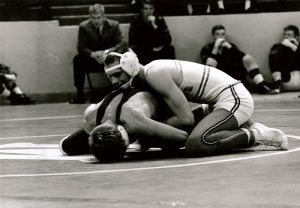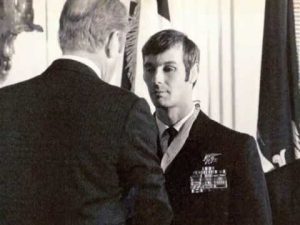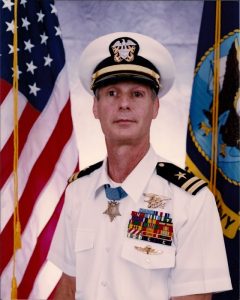
Norris Rescue Part of SEALS Legend
Reprinted from Glory Beyond the Sport: Wrestling and the Military
By Roger Moore
It’s a story the Navy SEALS will talk about forever.
Hollywood turned it into a movie.
A book was written about the incredible rescue.
Tom Norris, who received the Medal of Courage from the National Wrestling Hall of Fame in 2014, simply said it was all in the line of duty.
A three-year starter on the Maryland wrestling team, Norris won Atlantic Coast Conference championships in 1965 and 1966. After graduating in ’66, Norris entered training for the Navy SEALS – units created in the late 1950s for counter insurgency, guerrilla warfare and special operations.
for counter insurgency, guerrilla warfare and special operations.
Norris’ heroic actions in Quang Tri Province, Vietnam, from 10-13 April in 1972, were the subject of a book and movie entitled “The Rescue of Bat 21.”
After several failed rescue attempts of two downed pilots deep inside enemy territory which included 11 casualties, Lt. Norris was selected to put together a small team.
The pilots were in a U.S. electronic surveillance aircraft downed by an enemy surface-to-air missile. Lieutenant Colonel Iceal Hambleton was the sole member to eject safely – but he parachuted into 30,000 North Vietnamese troops.
Over the next several days, during extensive rescue efforts, four aircraft were downed, 10 Americans killed, two captured and another two were trapped behind enemy lines.
On the night of April 10, Norris led a 5-man patrol through 2,000 meters of enemy territory, eventually locating one of the downed pilots (Lt. Mark Clark) and returning to the Forward Operating Base (FOB).
A night later, after a devastating mortar and rocket attack, Norris led a 3-man team on two unsuccessful rescue att empts of the other pilot.
empts of the other pilot.
On April 12, Norris received information detailing the second pilot’s location. Dressed in fisherman disguises and using a sampon, Norris and Kiet Nguyen, a native Vietnamese traveled through the night and found the injured pilot (Hambleton) at dawn. Covering the pilot with vegetation and bamboo, they began the journey back to FOB, successfully evading a North Vietnamese patrol.
Approaching FOB, they came under heavy machine gun fire. Norris called in an air strike which eventually allowed the three to reach safety.
For his actions, Norris was awarded the Congressional Medal of Honor, presented by the President of the United States.
Several months later, Norris was leading a SEAL patrol on a reconnaissance mission when his team was ambushed by a large enemy unit. At the end of a long firefight, Norris ordered his men to head for the water and the boat waiting to pick them up.
While providing cover, Norris was shot in the head.
Ano ther SEAL, Michael Thornton, charged back to save him, killing two North Vietnamese about to dispatch him.
ther SEAL, Michael Thornton, charged back to save him, killing two North Vietnamese about to dispatch him.
For his action, Thornton would be awarded the Medal of Honor in October of 1973. Norris, who was hospitalized for three years, defied doctors’ orders and attended the White House ceremony.
In 1975 when the rescue of Clark and Hambleton was finally declassified, Navy investigators talked with those involved and submitted the action for review. On March 6, 1976, with Thornton in the audience, Norris was awarded the Medal of Honor by President Gerald Ford.
In 1979, after leaving the military, Norris joined the FBI where he retired in 1999.
CLICK HERE to WATCH the video from when Tom R. Norris received the Medal of Courage from the National Wrestling Hall of Fame in 2014.
CLICK HERE to purchase your copy of Glory Beyond the Sport: Wrestling and the Military for $15 with free shipping/handling.
By Roger Moore
It’s a story the Navy SEALS will talk about forever.
Hollywood turned it into a movie.
A book was written about the incredible rescue.
Tom Norris, who received the Medal of Courage from the National Wrestling Hall of Fame in 2014, simply said it was all in the line of duty.
A three-year starter on the Maryland wrestling team, Norris won Atlantic Coast Conference championships in 1965 and 1966. After graduating in ’66, Norris entered training for the Navy SEALS – units created in the late 1950s
 for counter insurgency, guerrilla warfare and special operations.
for counter insurgency, guerrilla warfare and special operations.Norris’ heroic actions in Quang Tri Province, Vietnam, from 10-13 April in 1972, were the subject of a book and movie entitled “The Rescue of Bat 21.”
After several failed rescue attempts of two downed pilots deep inside enemy territory which included 11 casualties, Lt. Norris was selected to put together a small team.
The pilots were in a U.S. electronic surveillance aircraft downed by an enemy surface-to-air missile. Lieutenant Colonel Iceal Hambleton was the sole member to eject safely – but he parachuted into 30,000 North Vietnamese troops.
Over the next several days, during extensive rescue efforts, four aircraft were downed, 10 Americans killed, two captured and another two were trapped behind enemy lines.
On the night of April 10, Norris led a 5-man patrol through 2,000 meters of enemy territory, eventually locating one of the downed pilots (Lt. Mark Clark) and returning to the Forward Operating Base (FOB).
A night later, after a devastating mortar and rocket attack, Norris led a 3-man team on two unsuccessful rescue att
 empts of the other pilot.
empts of the other pilot.On April 12, Norris received information detailing the second pilot’s location. Dressed in fisherman disguises and using a sampon, Norris and Kiet Nguyen, a native Vietnamese traveled through the night and found the injured pilot (Hambleton) at dawn. Covering the pilot with vegetation and bamboo, they began the journey back to FOB, successfully evading a North Vietnamese patrol.
Approaching FOB, they came under heavy machine gun fire. Norris called in an air strike which eventually allowed the three to reach safety.
For his actions, Norris was awarded the Congressional Medal of Honor, presented by the President of the United States.
Several months later, Norris was leading a SEAL patrol on a reconnaissance mission when his team was ambushed by a large enemy unit. At the end of a long firefight, Norris ordered his men to head for the water and the boat waiting to pick them up.
While providing cover, Norris was shot in the head.
Ano
 ther SEAL, Michael Thornton, charged back to save him, killing two North Vietnamese about to dispatch him.
ther SEAL, Michael Thornton, charged back to save him, killing two North Vietnamese about to dispatch him.For his action, Thornton would be awarded the Medal of Honor in October of 1973. Norris, who was hospitalized for three years, defied doctors’ orders and attended the White House ceremony.
In 1975 when the rescue of Clark and Hambleton was finally declassified, Navy investigators talked with those involved and submitted the action for review. On March 6, 1976, with Thornton in the audience, Norris was awarded the Medal of Honor by President Gerald Ford.
In 1979, after leaving the military, Norris joined the FBI where he retired in 1999.
CLICK HERE to WATCH the video from when Tom R. Norris received the Medal of Courage from the National Wrestling Hall of Fame in 2014.
CLICK HERE to purchase your copy of Glory Beyond the Sport: Wrestling and the Military for $15 with free shipping/handling.